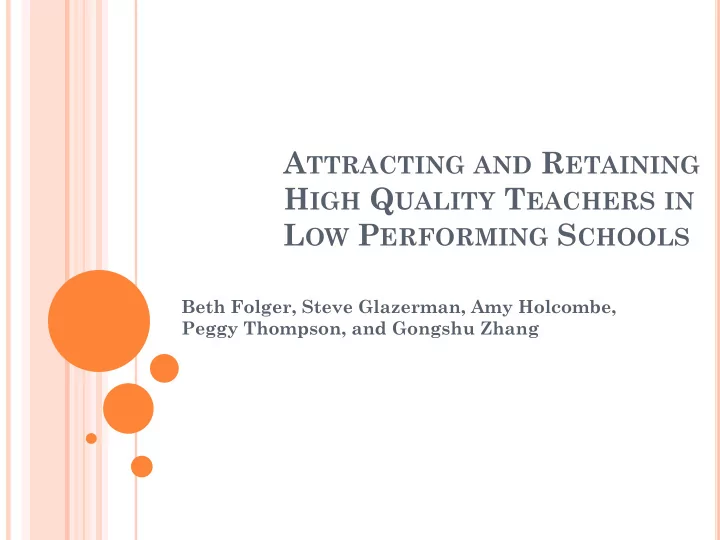

A TTRACTING AND R ETAINING H IGH Q UALITY T EACHERS IN L OW P ERFORMING S CHOOLS Beth Folger, Steve Glazerman, Amy Holcombe, Peggy Thompson, and Gongshu Zhang
P URPOSE Why: To provide rationale for additional support for low performing schools What: To examine a model for identifying the best teachers to low performing schools How: To share strategies for identifying the schools and the teachers When: To share proposed timelines and next steps
R ECRUITING AND R ETAINING E FFECTIVE T EACHERS IN U RBAN S CHOOLS The quality and effectiveness of teachers is by far the most powerful determinant of children’s educational success or failure The effects of teacher quality far outweigh those of any other measured school resource, including class size, and the effects are larger for disadvantaged, minority, and lower performing students Source: Snipes, Jason and Horwitz, Amanda. Recruiting and Retaining Effective Teachers in Urban Schools , Council of Great City Schools Research Brief, Fall, 2007, p. 2.
T HE CHALLENGE Distribution of high quality teachers Schools and school districts serving high proportions of poor and minority students have fewer high quality teachers than do schools and school districts serving their white, more advantaged counterparts. Source: Snipes, Jason and Horwitz, Amanda. Recruiting and Retaining Effective Teachers in Urban Schools , Council of Great City Schools Research Brief, Fall, 2007, p. 3.
T HE CONSEQUENCES Data from Value-added Research — The Tennessee Study …on average, low achieving students gained about 14 points each year on the Tennessee state test when taught by the least effective teachers, but more than 53 points when taught by the most effective teachers. These teacher effects appear to be cumulative. For example, Tennessee students who have three highly effective teachers in a row score more than 50 percentile points above their counterparts who have three ineffective teachers in a row — even when they started with the same score.” Source: Peske, Heather G. and Haycock, Kati. Teacher Inequality: How Poor and Minority Students are Shortchanged on Teacher Quality. A Report and Recommendations by the Education Trust, p.9-11.
S TRATEGIES FOR MEETING THE DEMAND : T EACHER C OMPENSATION “A growing number of state and national policymakers, researchers, teachers, and others are beginning to demand reforms in the way teachers are paid, in the belief that the prevailing salary structure in public schools does not attract and retain high quality teachers or elicit high levels of effort from existing teachers.” Source: Goldhaber, Dan and Eide, Eric. Teacher Compensation and Teacher Quality , Educational Research Service, 2003, p. 9.
T EACHER C OMPENSATION , C ONTD . “Supporters of merit pay structures based on student achievement measures believe that this compensation strategy will help attract individuals into the profession who will be standout performers and better teachers. Moreover, they argue that this pay structure creates incentives for teachers to constantly improve, which should result in better teaching.” Source: Goldhaber, Dan and Eide, Eric. Teacher Compensation and Teacher Quality , Educational Research Service, 2003, p. 43.
S TRATEGY FOR A TTRACTING AND R ETAINING H IGH Q UALITY T EACHERS : T HE RESEARCH PILOT Mathematica Background Past research and implications for policy Attracting and Retaining High Quality-the model Identifying high performing teachers and the schools that need them Providing differentiated pay for those teachers ($10,000 per year for 2 years) Other compensation for participants Determining impact on student achievement Number of teachers to participate in the research model will be approximately 6-8 The research design and the evaluation of effectiveness
T HE P ROCESS Rank order elementary and middle schools by using Math composite scores for 07-08 Determine experimental and control group schools by lottery Identify high performing teachers based on 3 years of value-added scores Invite those teachers to a meeting to explore their interest Use available openings at schools, and allow principals to interview from this pool of teachers
P ARAMETERS Hold Mission Possible Schools harmless The need is great and the wealth can be shared Research underway with TIF grant by SERVE and Westat In the middle of a 5 year cycle Communicate that there is no forced movement of personnel Identified teachers will be provided the option of transfer, not the requirement Teachers will be moved into existing openings. No teachers will be displaced.
I MPLICATIONS AND N EXT S TEPS No cost to the district during the pilot Research study and salaries come from Mathematica December Meet with the principals of the experimental and control groups January Identify teachers using Value-Added Data Meet with the teachers to “invite” them to participate Collect a pool of individuals who are interested January-May Work with principals to staff vacancies from the pool of identified teachers
Recommend
More recommend